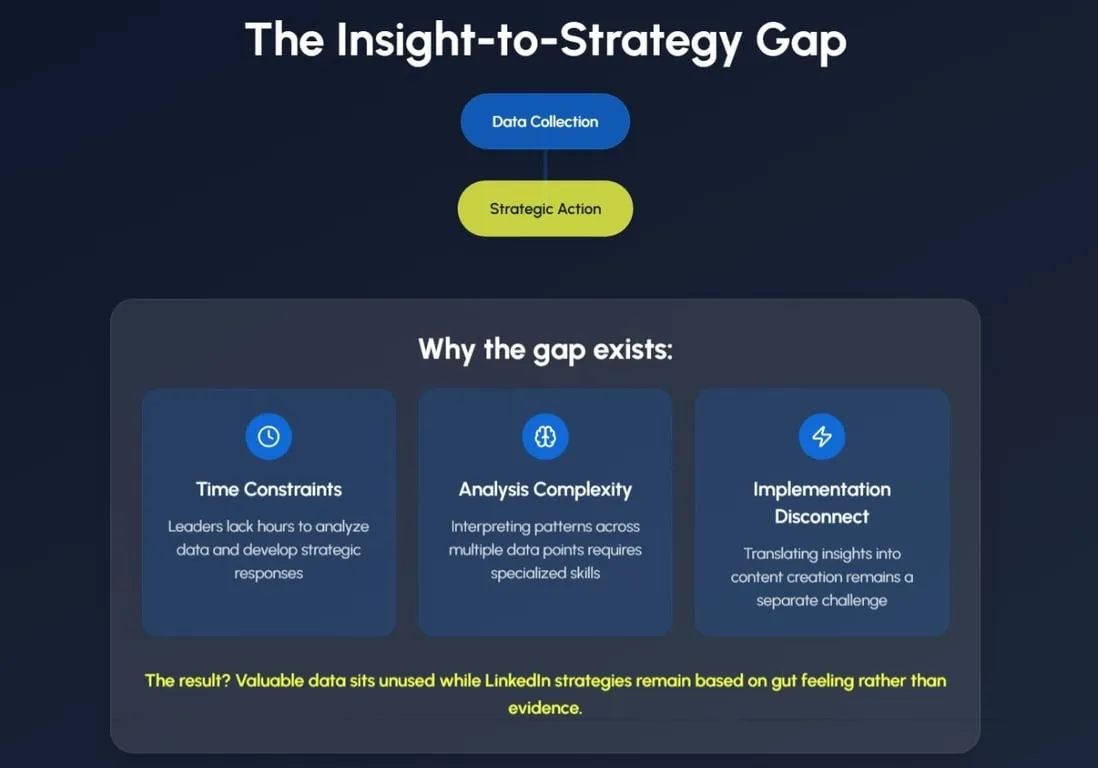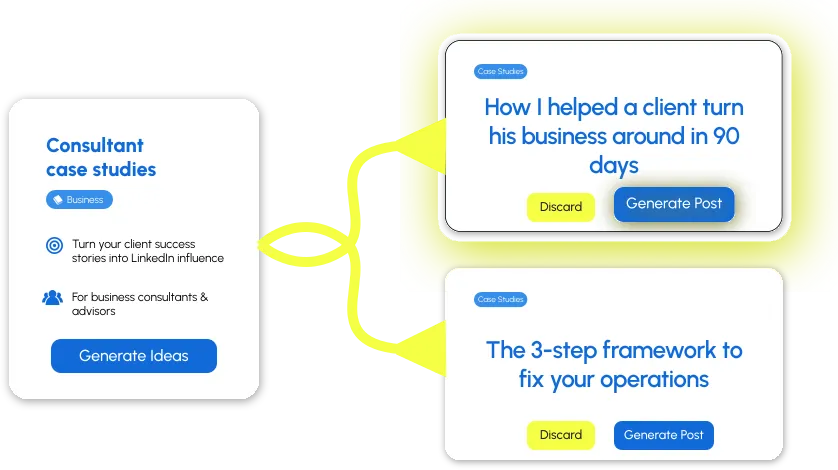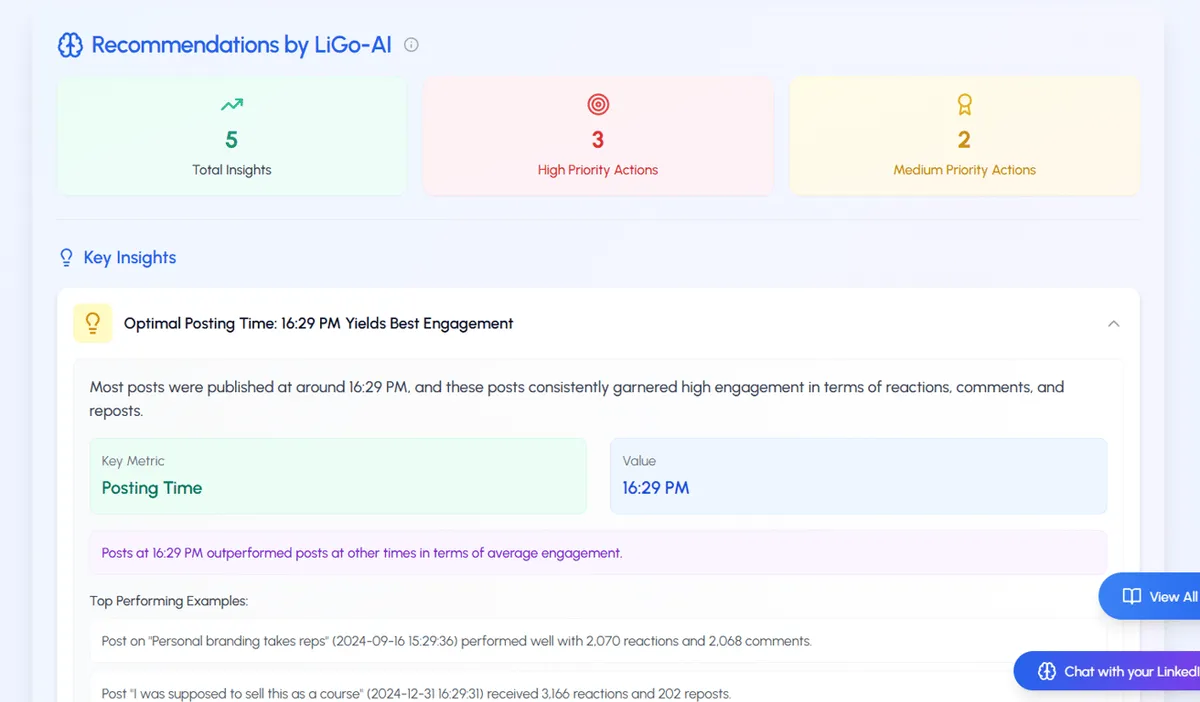For agency owners and founders, LinkedIn has evolved from a simple networking platform into the most powerful business growth engine available in 2025.
Yet here's the challenge most professionals face: despite having access to more data than ever before, they struggle to effectively transform these insights into actionable marketing strategies that generate client results.
This comprehensive guide will show you how to bridge the gap between LinkedIn insights and strategic action, leveraging data to drive meaningful business growth.
Understanding LinkedIn Insights in 2025
LinkedIn's analytics capabilities have evolved significantly, offering professionals deeper visibility into their content performance, audience engagement, and business impact. For agency owners focused on results, understanding these insights is crucial for optimizing your LinkedIn strategy.
The Evolution of LinkedIn Analytics
LinkedIn has expanded its analytics offerings substantially, now providing:
-
More granular audience demographic data
-
Enhanced content performance metrics
-
Improved competitive benchmarking
-
Advanced engagement tracking
-
Deeper conversion analytics
These enhancements allow for more sophisticated strategy development based on actual performance data rather than assumptions or generic best practices.
Essential LinkedIn Insights to Track
The most effective LinkedIn insights strategy focuses on metrics that directly connect to business objectives rather than vanity numbers. Here are the key insights agency owners should prioritize:
Audience Insights
Demographic Breakdown: Understanding the industries, job titles, seniority levels, and company sizes of your audience helps tailor content to your ideal clients.
Engagement Patterns: Analyzing which segments of your audience engage most frequently with your content reveals opportunities for targeted messaging.
Growth Trends: Tracking how your audience composition changes over time helps identify emerging market opportunities and shifts in your appeal.
For deeper guidance on audience analysis, see our LinkedIn profile optimization guide which covers how to align your profile with audience insights.
Content Insights
Format Performance: Different content formats (text, images, documents, videos) typically perform differently with specific audiences. LinkedIn insights reveal which formats resonate best with your particular followers.
Topic Resonance: By analyzing engagement across different content themes, you can identify which topics generate the strongest response from your target audience.
Optimal Timing: LinkedIn insights show when your specific audience is most active and receptive to content, allowing for strategic posting schedules. Our research on the best time to post on LinkedIn by industry provides additional guidance on this topic.
Engagement Insights
Engagement Rate Trends: Tracking how engagement rates change over time reveals whether your content strategy is improving or declining in effectiveness.
Engagement Quality: Not all engagement is equal-comments typically indicate deeper interest than simple reactions. LinkedIn insights help distinguish between different types of engagement.
Viral Potential: Identifying which content generates shares provides valuable information about what your audience finds compelling enough to redistribute to their networks.
For a comprehensive framework on which metrics matter most at different stages, check out our LinkedIn analytics hierarchy guide.
The Insight-to-Strategy Gap
Here's where most LinkedIn users hit a roadblock: they collect data, they might even analyze it, but they struggle to transform these insights into concrete strategic actions.
This "insight-to-strategy gap" exists for three main reasons:
-
Time constraints: Agency owners and founders don't have hours to pore over analytics and develop strategic responses
-
Analysis complexity: Interpreting patterns across multiple data points requires specialized skills
-
Implementation disconnect: Even with good insights, translating them into content creation is a separate challenge
The result? Valuable data sits unused while LinkedIn strategies remain based on gut feeling rather than evidence.

Transforming Insights into Strategy: Practical Frameworks
Let's bridge this gap with practical frameworks that agency owners can implement immediately:
1. Audience-Driven Content Planning
Use demographic insights to develop content specifically tailored to your most valuable audience segments:
-
Identify the top 3-5 professional roles engaging with your content
-
Research the specific challenges these roles face in their work
-
Create content that directly addresses these challenges
-
Test different content approaches with each segment
-
Double down on what works based on engagement data
This targeted approach ensures your content speaks directly to the needs of your ideal clients rather than broadcasting generic messages. For guidance on implementing this approach, see our article on creating your LinkedIn content theme.
2. Format Optimization
LinkedIn insights reveal which content formats perform best with your specific audience:
-
Analyze performance across text posts, document posts, images, and videos
-
Identify patterns in format preference by topic and audience segment
-
Develop a strategic mix that leverages the highest-performing formats
-
Test new format approaches based on platform trends
-
Refine your format strategy based on ongoing performance data
As one study found, "Document posts (carousels) receive approximately 3x more engagement than standard posts, while video content has seen a 34% increase year-over-year, generating 1.4x more engagement."
For optimal results with document posts, review our LinkedIn carousel post size guide.
3. Strategic Timing Implementation
LinkedIn insights provide valuable data about when your audience is most receptive:
-
Identify the days and times when your content receives the highest engagement
-
Create a posting schedule aligned with these optimal windows
-
Test variations to validate and refine timing assumptions
-
Develop a consistent cadence that matches audience availability
-
Adjust timing strategies as audience behaviors evolve
This approach ensures your content appears when your audience is most likely to engage with it. For more on the importance of consistency, read our article on why scheduling LinkedIn posts is no longer optional.
4. Competitive Differentiation
LinkedIn's competitive insights help identify opportunities to differentiate your approach:
-
Analyze competitor content strategies and performance
-
Identify content gaps and underserved topics
-
Develop unique perspectives on common industry challenges
-
Monitor how audience engagement differs between your content and competitors'
-
Refine your positioning based on competitive performance data
As one marketing professional observed, "The essential factor is to cultivate a community; prioritizing community over mere followers is crucial."
Advanced Insights Strategies for Agency Owners
Beyond basic metrics, these advanced insights approaches help agency owners extract maximum value from their LinkedIn data:
Content Experimentation Framework
Implement a structured testing approach to continuously improve performance:
-
Form a clear hypothesis (e.g., "Posts with data visualizations will generate higher engagement than text-only posts")
-
Create test content that isolates the variable you're testing
-
Measure results against your control content
-
Implement successful approaches more broadly
-
Document learnings for future reference
This scientific approach yields more reliable insights than random experimentation and helps you develop a better understanding of your specific audience preferences.
Engagement-to-Lead Tracking
Connect LinkedIn engagement to actual business outcomes:
-
Implement tracking parameters on all LinkedIn links
-
Create dedicated landing pages for LinkedIn traffic
-
Track the journey from LinkedIn engagement to lead capture
-
Analyze which content types generate the highest-quality leads
-
Optimize your content strategy based on lead generation effectiveness
This approach ensures your LinkedIn strategy drives business results, not just engagement. Learn more about this in our guide on how to optimize your LinkedIn profile for lead generation.
Audience Segmentation Analysis
Develop deeper understanding of different audience segments:
-
Create custom audience segments based on industry, role, and company size
-
Analyze content performance across different segments
-
Develop segment-specific content strategies
-
Test messaging variations with each segment
-
Refine your targeting based on segment-specific insights
This segmented approach allows for more personalized content that resonates with specific audience groups.
Common LinkedIn Insights Mistakes to Avoid
Even experienced professionals make these common mistakes when implementing LinkedIn insights strategies:
1. Focusing on Vanity Metrics
The mistake: Prioritizing follower counts and likes over meaningful business outcomes.
The solution: Focus on metrics that directly connect to your business objectives, such as lead generation, website traffic, or client acquisition. For more on this topic, see our article on vanity metrics vs. authenticity on LinkedIn.
2. Analyzing Without Context
The mistake: Looking at metrics in isolation without considering industry benchmarks or historical performance.
The solution: Compare your metrics against industry averages, competitor performance, and your own historical data to gain meaningful context.
3. Failing to Connect Insights to Action
The mistake: Collecting data without implementing changes based on insights.
The solution: For each analytics review, identify specific actions to optimize your strategy based on what the data reveals.
4. Ignoring Audience Insights
The mistake: Focusing solely on content performance without understanding audience demographics and behavior.
The solution: Regularly review audience data to ensure you're reaching your target market and adjust your content strategy accordingly.
The Time Challenge: Why Most Insight-Driven Strategies Fail
While these strategies are powerful, there's one major obstacle that derails most LinkedIn insight-driven approaches: time.
Agency owners and founders juggle countless responsibilities-client work, team management, business development, and more. Finding time to consistently analyze data, identify patterns, develop strategic responses, and create optimized content often feels impossible.
This time constraint is the primary reason most LinkedIn analytics efforts fail to drive strategic change-not because the insights aren't valuable, but because implementing them consistently while juggling other priorities is extremely challenging.
How LiGo Bridges the Insight-to-Strategy Gap
For agency owners and founders juggling multiple responsibilities, LiGo offers a comprehensive solution to this challenge:
Theme-Based Performance Analysis
LiGo's theme-based approach allows you to track which content themes and topics generate the strongest engagement with your specific audience, informing more strategic content planning.
Unlike basic analytics that simply show engagement numbers, LiGo connects performance data directly to content themes, helping you understand not just what's working, but why it's working.

AI-Powered Insight Generation
LiGo's analytics dashboard doesn't just present data-it actively analyzes patterns and delivers specific, prioritized recommendations:
-
"Posts discussing specific client success stories receive 43% higher engagement than general industry commentary"
-
"Content published between 8-10am on Tuesdays generates 35% more comments than other times"
-
"Document posts with 5-7 slides outperform both shorter and longer formats by 28%"
These AI-generated insights eliminate the need for manual analysis, saving hours of time while providing more accurate pattern recognition than human analysis alone.

Closed-Loop Implementation
Here's where LiGo truly stands apart: it doesn't just identify what's working-it helps you immediately create more content based on those insights.
For example, when LiGo identifies that posts about "agency scaling strategies" perform exceptionally well with your audience, you can immediately:
-
Generate new content ideas within that successful theme
-
Create complete posts optimized for the formats that perform best
-
Schedule them for the times when your audience is most engaged
This closed-loop system eliminates the gap between insight and implementation that plagues most LinkedIn strategies.
Memory-Enhanced Analytics
LiGo's analytics system connects insights with your content history, maintaining a comprehensive view of what works specifically for your voice and expertise over time.
This longitudinal analysis reveals patterns that might be missed in snapshot analytics, helping you develop a more nuanced understanding of your audience's preferences and how they evolve.
To see how this works in practice, check out our guide on how to use LiGo analytics to refine your LinkedIn strategy.
Practical Implementation: A 21-Day LinkedIn Insights Action Plan
For agency owners ready to implement an insights-driven LinkedIn strategy, this 21-day plan provides a structured approach:
Days 1-7: Baseline Analysis
-
Review your audience demographics and identify primary segments
-
Analyze your top 10 performing posts from the past quarter
-
Identify patterns in format, topic, and timing
-
Establish key performance metrics aligned with business goals
-
Create a content theme map based on audience interests
-
Document baseline engagement rates for different content types
-
Set up tracking for LinkedIn-to-website conversions
Days 8-14: Strategic Implementation
-
Develop content focused on your highest-performing theme
-
Create multiple format variations (text, carousel, image)
-
Schedule posts at times indicated by your analytics
-
Engage strategically with your target audience
-
Test a new content approach based on competitive analysis
-
Track initial performance against baseline metrics
-
Adjust approach based on preliminary results
Days 15-21: Optimization and Systemization
-
Analyze performance data from your strategic implementation
-
Identify the highest-performing formats and topics
-
Create a content calendar emphasizing proven approaches
-
Develop templates for your most effective content types
-
Establish a regular analytics review process
-
Document insights in a knowledge base for future reference
-
Create a sustainable weekly routine for ongoing optimization
For a broader strategy on building sustainable growth, read our guide on LinkedIn growth systems: building sustainable success.
Conclusion: From Insights to Impact
For agency owners and founders, LinkedIn insights should never be about collecting numbers for their own sake. The true value lies in translating these insights into strategic decisions that enhance your professional presence and drive business growth.
The most effective approach combines:
-
Clear business objectives tied to specific metrics
-
Regular analysis of performance data
-
Strategic adjustments based on insights
-
Continuous testing and optimization
By implementing the insights framework outlined in this guide-and leveraging tools like LiGo to bridge the insight-to-strategy gap-you can transform your LinkedIn presence from a time-consuming obligation into a data-driven business development engine.
Remember that LinkedIn insights analysis is an ongoing process, not a one-time assessment. The professionals who achieve the greatest success are those who consistently measure, learn, and adapt their approach based on real performance data rather than assumptions or generic best practices.




